-
1 of 253523 objects
Padshahnamah پادشاهنامه (The Book of Emperors) 1656-57
Manuscript on paper, with 22 single and 11 double-page miniatures, many by leading Mughal court artists. Fine illuminated shamsahs on fol. 1v-2r, gold arabesque designs on the border of each folio. Nastaliq caligraphy by Muhammad Amin Mashhadi. | 58.6 x 36.8 cm (book measurement (conservation)) | RCIN 1005025
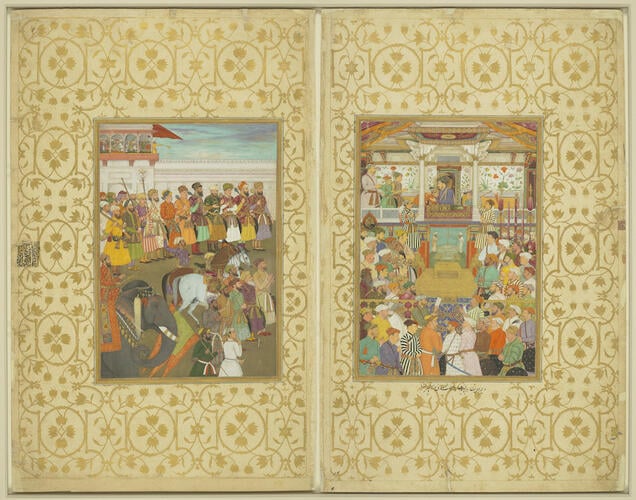
Abd al-Hamid Lahawri
Master: Padshahnamah پادشاهنامه (The Book of Emperors) Item: Shah-Jahan receives his three eldest sons and Asaf Khan during his accession ceremonies (8 March 1628) 1656-57
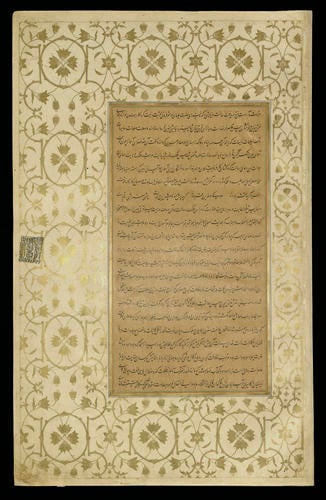
Abd al-Hamid Lahawri
Master: Padshahnamah پادشاهنامه (The Book of Emperors) Item: Text block of the Padshahnama manuscript 1656-57
Abd al-Hamid Lahawri
Master: Padshahnamah پادشاهنامه (The Book of Emperors) Item: Text block of the Padshahnama manuscript 1656-57
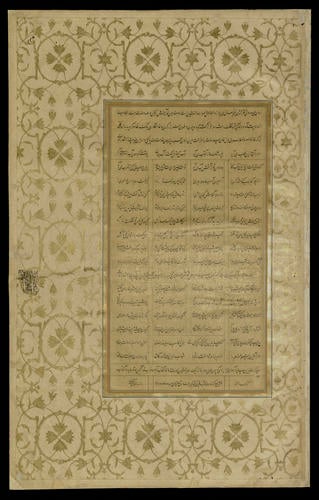
Abd al-Hamid Lahawri
Master: Padshahnamah پادشاهنامه (The Book of Emperors) Item: Text block of the Padshahnama manuscript 1656-57

Abd al-Hamid Lahawri
Master: Padshahnamah پادشاهنامه (The Book of Emperors) Item: Padshahnamah manuscript covers 1656-57
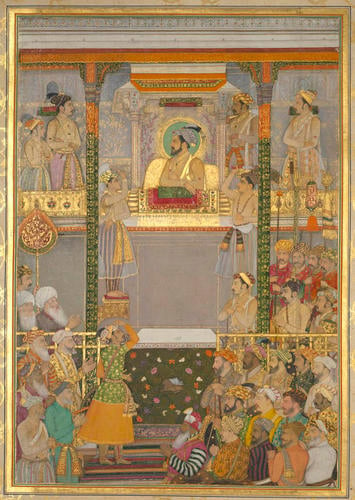
Abd al-Hamid Lahawri
Master: Padshahnamah پادشاهنامه (The Book of Emperors) Item: Shah-Jahan honouring Prince Awrangzeb at Agra before his wedding (27 April 1637) 1656-57
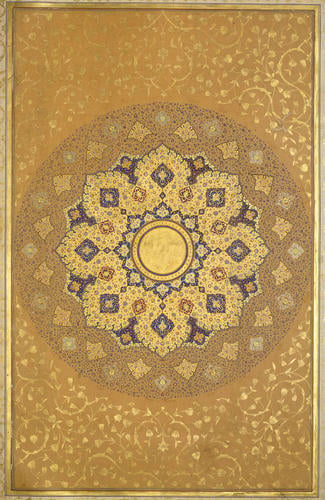
Abd al-Hamid Lahawri
Master: Padshahnamah پادشاهنامه (The Book of Emperors) Item: The Padshahnamah : opening shamsah (sunburst) 1656-57
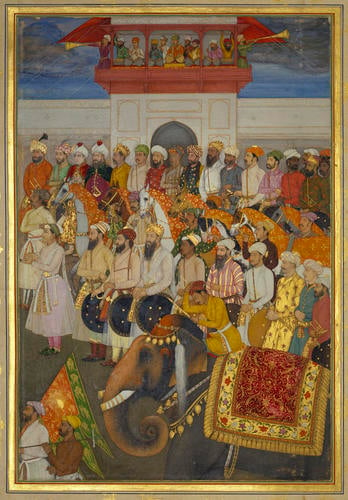
Abd al-Hamid Lahawri
Master: Padshahnamah پادشاهنامه (The Book of Emperors) Item: Jahangir receives Prince Khurram on his return from the Deccan (10 October 1617) 1656-57
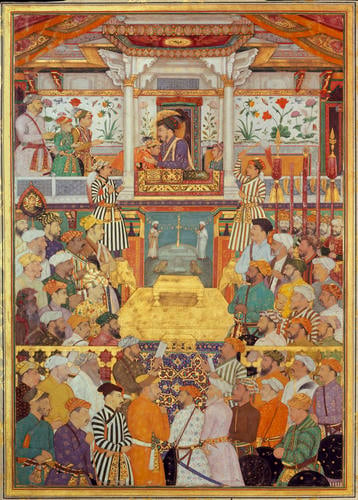
Abd al-Hamid Lahawri
Master: Padshahnamah پادشاهنامه (The Book of Emperors) Item: Shah-Jahan receives his three eldest sons and Asaf Khan during his accession ceremonies (8 March 1628) 1656-57
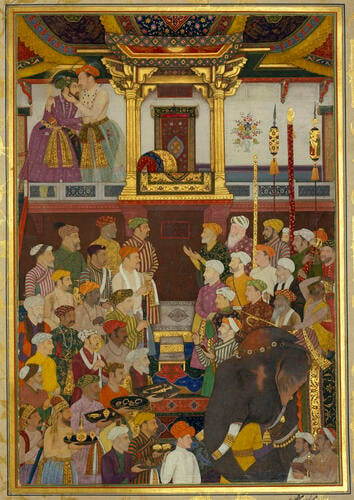
Abd al-Hamid Lahawri
Master: Padshahnamah پادشاهنامه (The Book of Emperors) Item: Jahangir receives Prince Khurram on his return from the Deccan (10 October 1617) 1656-57
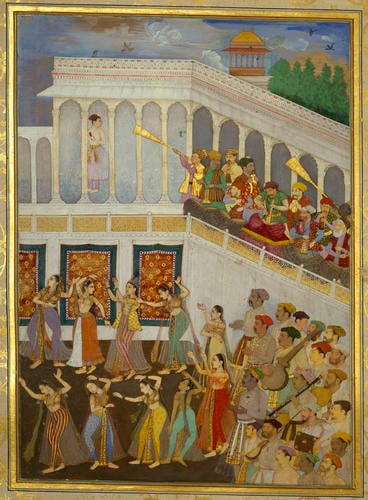
Abd al-Hamid Lahawri
Master: Padshahnamah پادشاهنامه (The Book of Emperors) Item: The Weighing of Shah-Jahan on his 42nd lunar birthday (23 October 1632) 1656-57
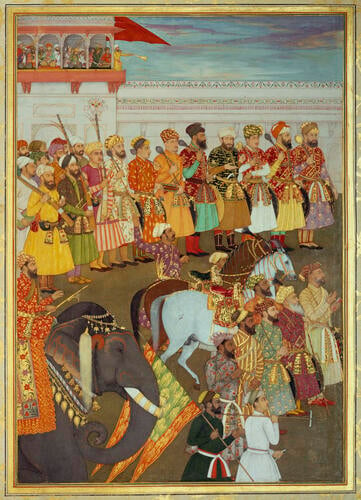
Abd al-Hamid Lahawri
Master: Padshahnamah پادشاهنامه (The Book of Emperors) Item: Shah-Jahan receives his three eldest sons and Asaf Khan during his accession ceremonies (8 March 1628) 1656-57
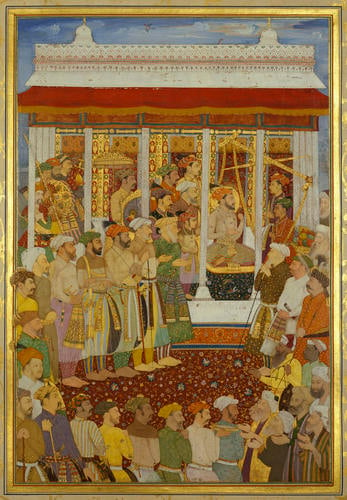
Abd al-Hamid Lahawri
Master: Padshahnamah پادشاهنامه (The Book of Emperors) Item: The Weighing of Shah-Jahan on his 42nd lunar birthday (23 October 1632) 1656-57
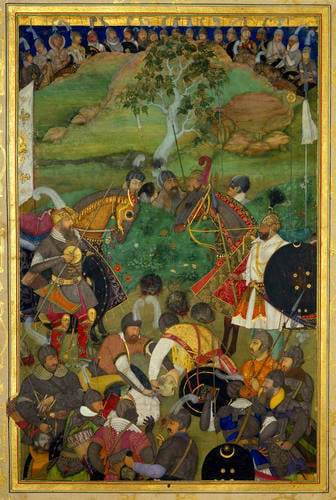
Abd al-Hamid Lahawri
Master: Padshahnamah پادشاهنامه (The Book of Emperors) Item: The Decapitation of Khan Jahan Lodi (3 February 1631) 1656-57

Abd al-Hamid Lahawri
Master: Padshahnamah پادشاهنامه (The Book of Emperors) Item: Europeans bring gifts to Shah-Jahan (July 1633) 1656-57
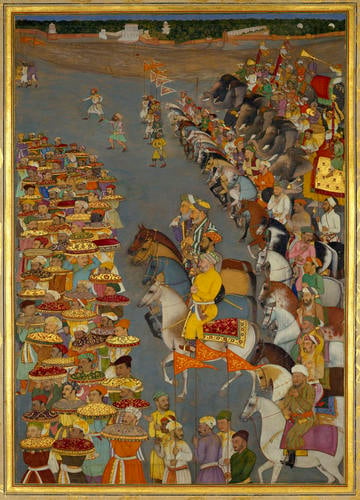
Abd al-Hamid Lahawri
Master: Padshahnamah پادشاهنامه (The Book of Emperors) Item: The Delivery of presents for Prince Dara-Shikoh's wedding (November-December 1632) 1656-57
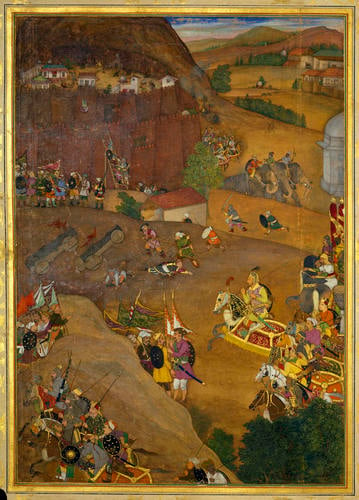
Abd al-Hamid Lahawri
Master: Padshahnamah پادشاهنامه (The Book of Emperors) Item: Azam Khan captures Fort Dharur (January 1631) 1656-57
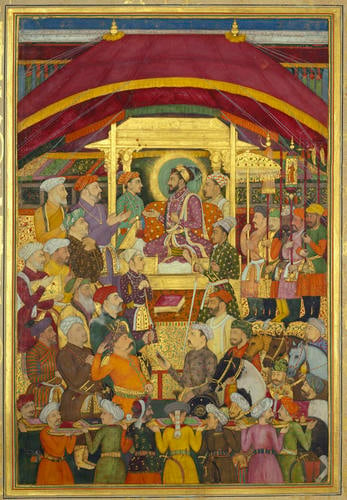
Abd al-Hamid Lahawri
Master: Padshahnamah پادشاهنامه (The Book of Emperors) Item: Shah-Jahan receives the Persian ambassador, Muhammad-Ali Beg, during the New Year celebrations (March 1631) 1656-57
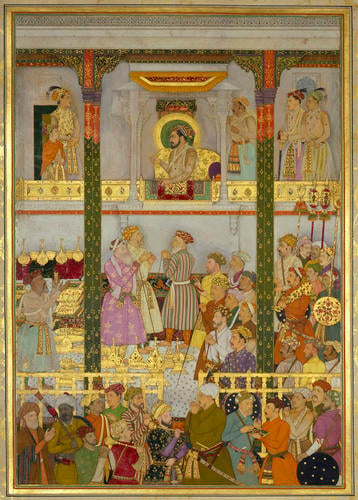
Abd al-Hamid Lahawri
Master: Padshahnamah پادشاهنامه (The Book of Emperors) Item: The exhibition of New Year gifts (March 1631) 1656-57
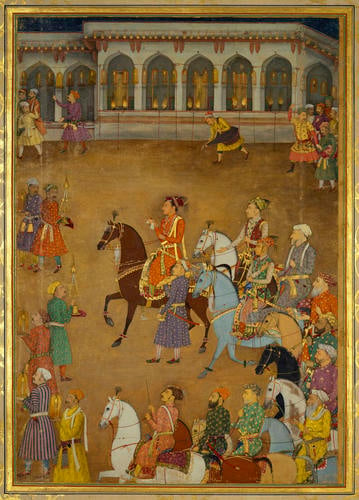
Abd al-Hamid Lahawri
Master: Padshahnamah پادشاهنامه (The Book of Emperors) 1656-57

Abd al-Hamid Lahawri
Master: Padshahnamah پادشاهنامه (The Book of Emperors) Item: Shah-Jahan honouring Prince Dara-Shukoh at his wedding (12 February 1633) 1656-57
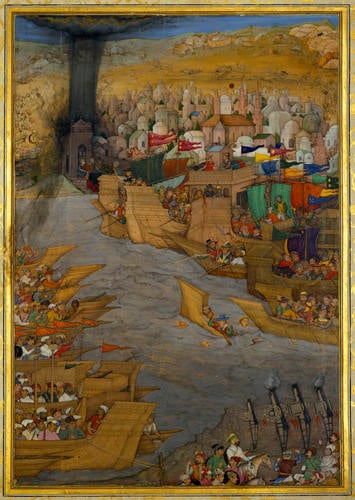
Abd al-Hamid Lahawri
Master: Padshahnamah پادشاهنامه (The Book of Emperors) Item: The Capture of Port Hugli (June-October 1632) 1656-57





















-
An illustrated chronicle of the reign of Shah-Jahan, the fifth Mughal emperor, presented by the Nawab of Awadh to George III in 1798. The manuscript contains some of the finest Mughal paintings ever produced.
Shah-Jahan commissioned the Padshahnamah (‘Book of Emperors’) as a propagandist celebration of his reign and dynasty. The text is a detailed chronological narrative of each day of the emperor's reign, describing his daily activities, court ceremonies and the honours he bestowed on the members of his nobility. This manuscript in the Royal Collection is unique, being the only contemporary illustrated imperial Padshahnamah volume to survive. It contains only the first of the three volumes which make up the text. Its content comprises a preface; Shah-Jahan’s horoscope; an account of the Mughal imperial genealogy from Timur to Jahangir; then the greater part of the manuscript is a discourse on the first decade of Shah-Jahan’s rule (1628–38). The book ends with an epilogue listing in order of hierarchy the nobles, officials and religious figures who feature in the narrative.
The author, Abd al-Hamid Lahawri wrote the Persian text as a combination of prose and verse written in an ornate style full of complex allegory and flowery metaphors. His preface describes it as ‘an adorned text, the description of which fills the listener’s dress with jewels’.
The colophon on folio 239r gives the name of the calligrapher and the date of the manuscript’s completion. It reads ‘the slave, the poor / the sinful, Muhammad Amin of Mashhad 1067 [1656– 7]’. Muhammad Amin was an Iranian emigre to the Mughal court already in his 70s by this time. He wrote the text in nastaliq script in black and gold ink, 21 lines per page, on heavily burnished brown paper densely flecked with gold paint.
The opening pages of the manuscript are decorated with a pair of illuminated shamsahs (‘sunbursts’) symbolising divine light (see RCINs 1005025.a and .b) Following the shamshas is an illuminated double page frontispiece with portraits of Shah-Jahan and Timur. When the two paintings are read together the images imply that Timur, the great ruler of Central Asia and the progenitor of the Mughal dynasty, is passing the imperial Timurid crown to Shah-Jahan (see RCINs 1005025.c and .d).
The decorative heading of the first text page of the manuscript was only outlined and never illuminated, suggesting that the manuscript’s decoration ceased suddenly in c.1658. The manuscript’s outer borders of pale brown paper date to the early 17th century and are ornamented with the same trellis design of freehand gold illumination throughout. Rulings in opaque watercolour and gold paint cover the join between the text pages and the borders.
The paintings of this manuscript are among the most important Mughal paintings ever made (see RCINs 1005025.d – 1005025.au). They depict significant events in Emperor Shah-Jahan’s life: magnificent durbars, lavish processions, and glorious victories on the battlefield – and can all confidently be dated to the 1630s, 1640s and 1650s. Some of the paintings are signed by Shah-Jahan’s artists (Abid, Balchand, Bichitr, Bishan Das, Payag, Dawlat, Bulaqi, Bhola and Murar) and many include their self-portraits.
The manuscript appears to have been re-bound at least twice in its history. Binding (or re-binding) appears to have been carried out in the first quarter of the 18th century: the inner covers and parts of the leather spine (which are decorated in the same pattern as appears in the borders of the album RCIN 1005068) date to this period. The text was sewn in three parts at this point, but damage to the spine (likely due to the pressure caused by such a heavy manuscript) led to its rebinding in five parts, likely in the 1780s, with the addition of new outer covers (see RCIN 1005025.av).
The fact that the decorative heading of the first text page was only outlined and never illuminated indicates that the manuscript’s embellishment ceased suddenly. The lack of imperial inscriptions or seal impressions at the centre of the Shamsahs, usually found in volumes completed for Shah-Jahan, suggests the volume never officially entered the emperor’s library. Similarly, dedications to the emperor in the colophon, typical in an imperial manuscript, are noticeably absent, possibly suggesting this was intended as just the first of a three-volume commission. Saqib Baburi (2010) suggests the manuscript’s current form dates to the reign of Farrukh-Siyar (r. 1713–19), who saw himself as the second Shah-Jahan, naming the history of his own reign, ‘the Padshahnamah of Farrukh-Siyar’. It is likely that the margins, inside covers and loose interleaf explanatory sheets between the paintings date from this period. Only four, now largely obscured, seal impressions (on the shamsa folios and reverse of the final folio) were made on the manuscript prior to its purchase by Asaf-al Dawla, the Nawab of Awadh in the 1780s. A back seal impression of Asaf al-Dawla is present at the centre left edges of each folio.
Following Asaf al-Dawla’s death in 1797, his son Ali ruled for only four months before he was deposed at the intervention of Sir John Shore (later Lord Teignmouth, Governor-General 1793–8). Asaf al-Dawla’s brother, Saadat Ali Khan, was installed as Nawab of Lucknow instead in early 1798 and it was at the time of his installation that he presented the Padshahnamah as a gift to the Governor-General, a well-known bibliophile.
A memo dated June 1799 (RCIN 1005091) records:
'When Lord Teignmouth was at Lucknow, a Book was produced for him out of the Nabob's Library, as a most splendid specimen of oriental manuscripts and its acceptance was pushed upon him. Lord Teignmouth declined receiving it with an observation that it was fit for a royal Library. The observation however suggested the Idea, that as a literary curiosity it might be acceptable to the King of Great Britain & he mentioned afterwards to the Minister at Lucknow, that he would not hesitate to accept it, in the Idea of depositing it in the royal Library if his Majesty would think it proper to allow it. The Book, with five others selected by the Minister, as elegant specimens of Persian writing, were sent to Calcutta, after Lord Teignmouth's Departure, & forwarded by his Attorneys to Europe. They have been latterly received by Lord Teignmouth, and are now in his possession; he will be happy to be honoured with his Majesty's orders respecting them.'
George III did accept the volumes and Lord Teignmouth wrote a note describing it to him:
‘The History of the Reign of the Emperor Shahjehan – son of Jehangiur & father of Aurangzebe. This is the most splendid Persian manuscript I ever saw. Many of the faces are very well painted & some of them are portraits. The first is a portrait of Timur or Tamerlane, & the second that of Shahjehan. This was the Book which was shown to me at Lucknow, & I was then informed that the deceased Nabob Asoph uddoulah purchased it for 12000 [?] Rupees – about £1500.’
The five volumes (this and RCINS 1005015, 1005017, 1005022, 1005032 and 1005068) were brought to George III’s library at the Queen’s House, now Buckingham Palace, where they were made available to scholars and visitors.
The manuscript was disbound in 1993 and the paintings remain separated from the text folios.Further Reading:
Milo Beach and Ebba Koch, King of the world : the Padshahnama, an imperial Mughal manuscript from the Royal Library, Windsor Castle, 1996.
Saqib Baburi, Beyond the Akbarnama: Padshahnamahs and Official Regnal Chronography for Shah-Jahan Padshah (r. 1037/1628-1068/1658), 2010.Provenance
Formerly in the Mughal imperial library. Acquired by Asaf al-Dawlah, Nawab of Awadh, c.1780-90. Presented by Saadat Ali Khan, Nawab of Awadh, to George III via Lord Teignmouth in June 1799.
-
Creator(s)
(calligrapher)(illustrator)(illustrator)(illustrator)(illustrator)(illustrator)(illustrator)(illustrator)(illustrator)(illustrator)(illustrator)(illustrator)(illustrator)(illustrator)(illustrator)(artist)(nationality)Acquirer(s)
-
Medium and techniques
Manuscript on paper, with 22 single and 11 double-page miniatures, many by leading Mughal court artists. Fine illuminated shamsahs on fol. 1v-2r, gold arabesque designs on the border of each folio. Nastaliq caligraphy by Muhammad Amin Mashhadi.
Measurements
58.6 x 36.8 cm (book measurement (conservation))
Category